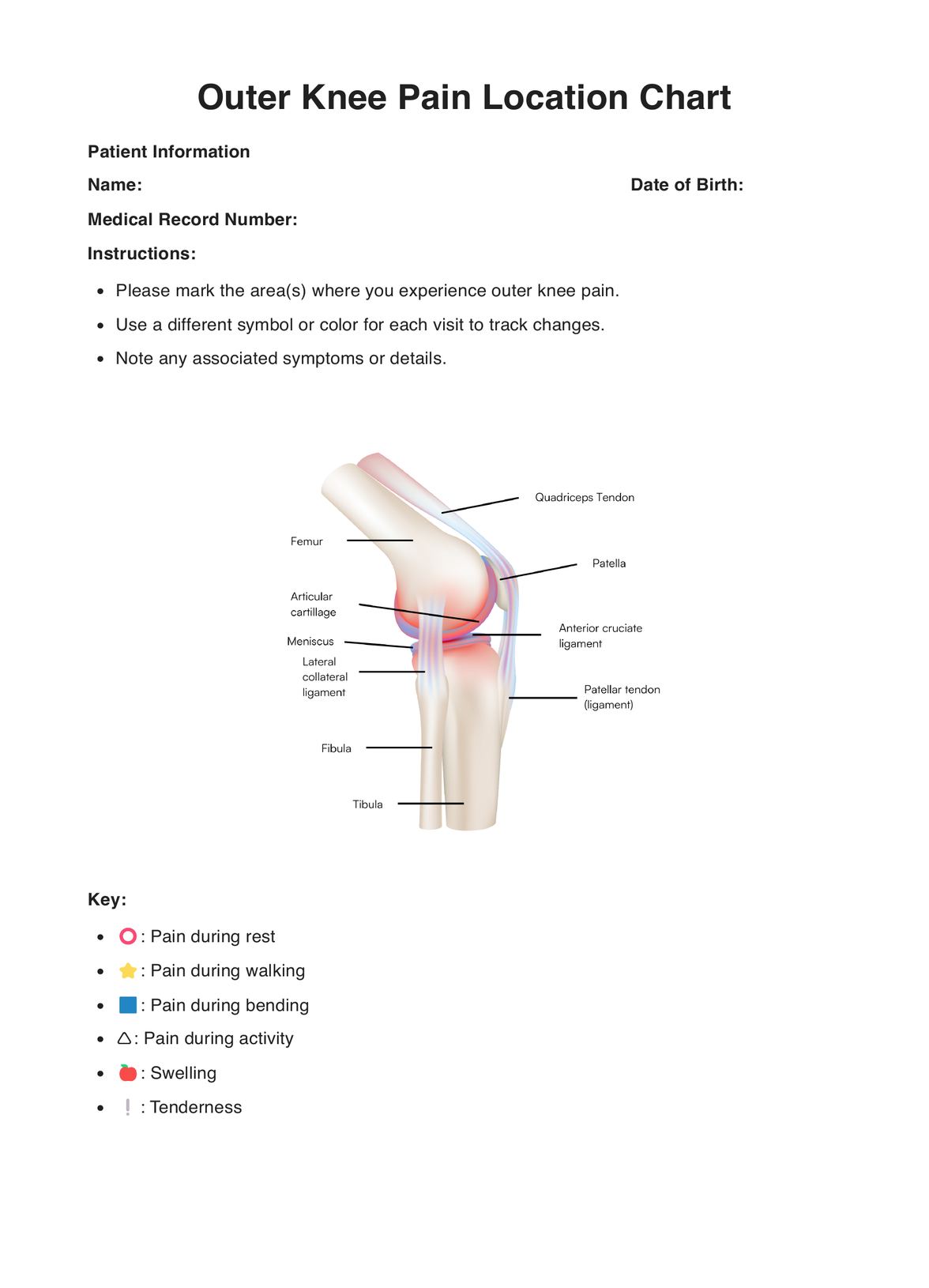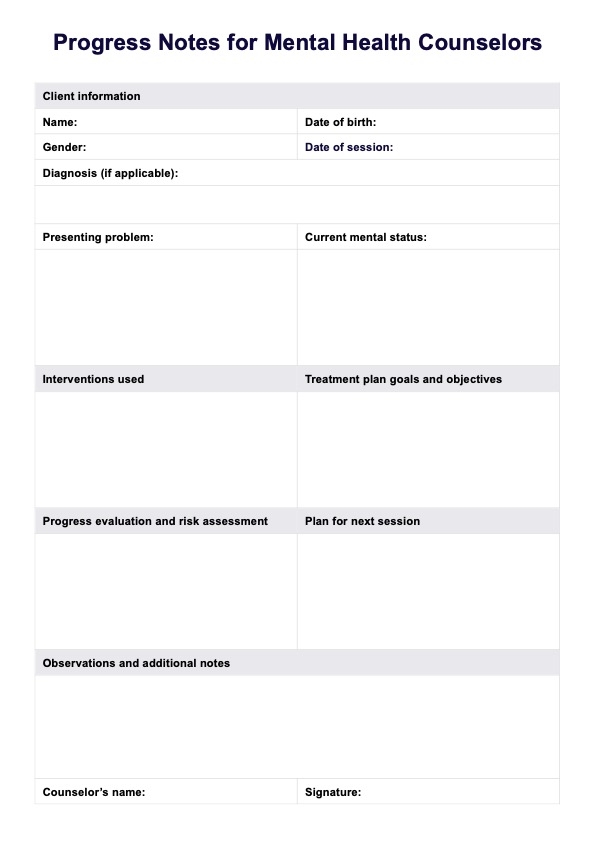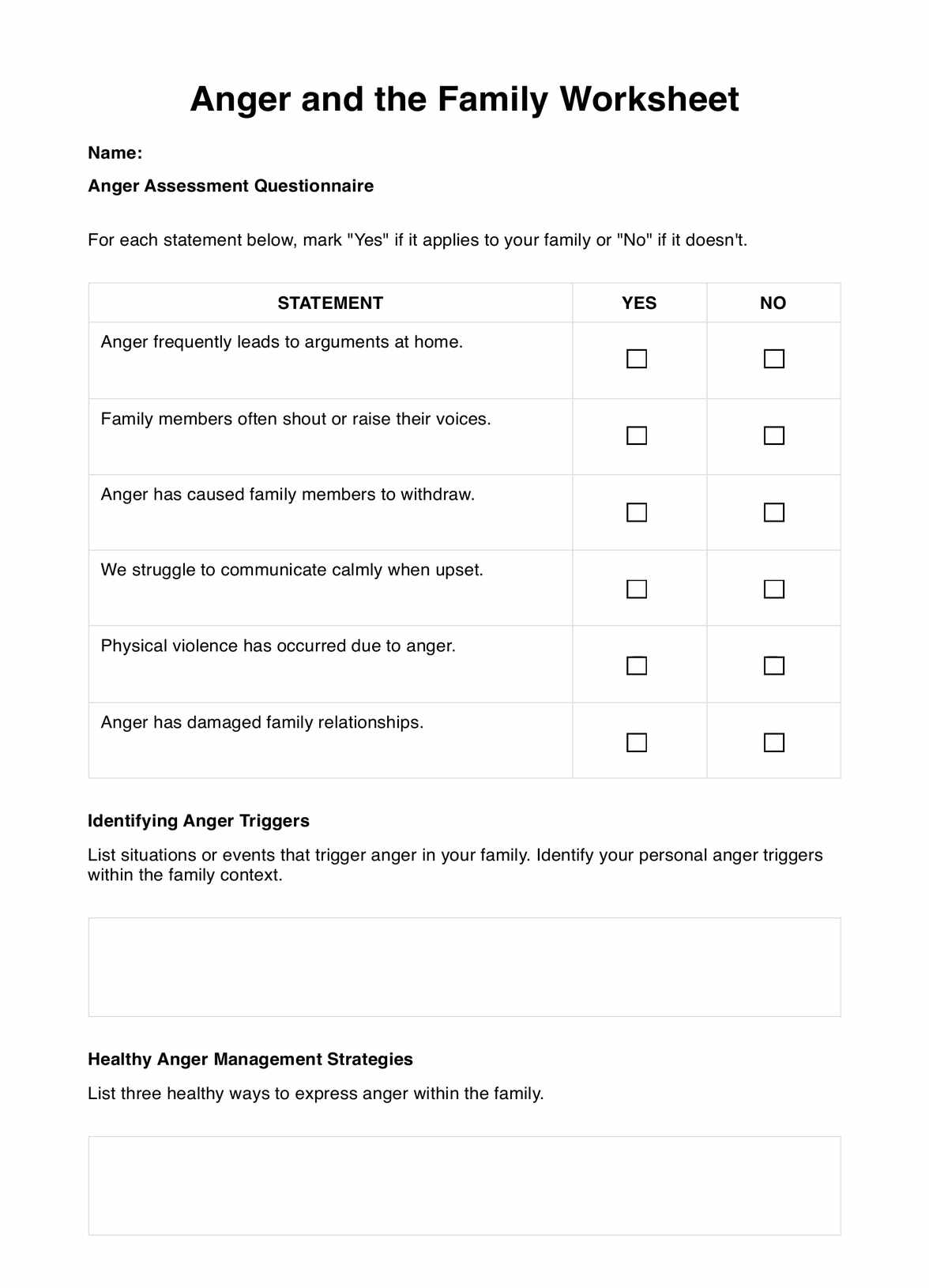Symptoms Of Low Self-Esteem Checklist
Discover the signs and symptoms of low self-esteem with our helpful checklist. This helps you assess your client’s thoughts, feelings & actions.


What are the Symptoms Of Low Self-Esteem Checklist?
Low self-esteem and a lack of confidence significantly impact individuals' self-perception and belief in their capabilities. These conditions can influence decision-making processes and shape the way people lead their lives. A checklist for self-reflection can identify familiar signs and help start taking proactive steps to build self-confidence and seek support.
The symptoms of low self-esteem checklist is a useful tool that can help people find and understand the usual signs and symptoms of low self-esteem. This checklist is useful for figuring out how you see yourself and identifying areas that may require work.
People with low self-esteem often have many signs on the list. By going through the checklist, readers can learn more about their own thoughts, feelings, and actions, which can help them think about themselves and become more self-aware.
Using the symptoms of low self-esteem checklists, people can compare their thoughts and behaviors to those on the list to see if the symptoms match their own. This self-evaluation can be a very important first step in recognizing and getting help for low self-esteem.
Also, this checklist pushes people to think about their own lives and determine how low self-esteem affects different parts of their lives. It gives people a place to start when they want to take steps to improve their self-image, build self-confidence, and improve their general well-being.
Because this checklist provides real-life cases, it can show how low self-esteem can appear in different situations, helping readers identify symptoms effectively. These examples show situations that readers can relate to, making it easier for them to spot the signs of low self-esteem and connect them to their own lives.
Symptoms Of Low Self-Esteem Checklist Template
Symptoms Of Low Self-Esteem Checklist Example
How does it work?
Symptoms of Low Self-Esteem to Print Checklists are helpful tools that help people figure out how they feel about themselves and look for signs of low self-esteem. These tests are useful tools for self-reflection and self-awareness that can help people with low self-esteem recognize and understand the problem. How they work is as follows:
Step one: Download the template
Start by going to the symptoms of low self-esteem checklist and printing it out. It is easy to use because it can be downloaded from our website and printed or edited directly using the PDF.
Step two: Have the client read through the list
Reading through each sign on the list will make sure that the client chooses the one that coincides with their own thoughts, feelings, and actions. Honesty will be important to get a clear picture of how they see themselves.
Step three: Check off and make notes
Clients will then check off their symptoms or make notes at the end to demonstrate how those symptoms apply to their lives. This approach will assist them in keeping track of and exploring the signs that correspond to their personal challenges.
Step four: Take some time to reflect
Individuals are encouraged to take some time to reflect on how these conditions impact their health, relationships, and personal growth. They should consider the various aspects of their lives that may be affected by low self-esteem and contemplate the changes they wish to pursue.
When would you use this Template?
The Symptoms of Low Self-Esteem Checklist template offers a systematic strategy for detecting and comprehending symptoms of low self-esteem. Here are some examples of when this material would be useful:
For self-evaluation to gain insights
The checklist is an excellent tool for people with poor self-esteem. They can acquire clarity and insight into their own ideas, emotions, and behaviors by going through the checklist, allowing them to assess the presence and severity of low self-esteem.
During therapy sessions with clients
Mental health practitioners will find the checklist helpful. It acts as a jumping-off point for discussions, allowing therapists to thoroughly grasp their clients' difficulties and adjust treatment strategies accordingly.
For personal development during support groups sessions
Facilitators of self-esteem and personal development support groups can use the checklist as a tool for participants to reflect on their own experiences. It enables group members to share ideas, swap coping skills, and offer mutual support.
In a classroom setting
Schools, universities, counselors, and educators can use the Symptoms of Low Self-Esteem Checklist as an educational resource. Students can get a better understanding of themselves and their peers by raising awareness about low self-esteem and its consequences.
Benefits
Individuals wishing to understand and resolve low self-esteem can benefit from using the Free Symptoms of Low Self-Esteem Checklist. Here are some significant benefits of using this template:
Leads to self-awareness
By highlighting specific symptoms associated with poor self-esteem, the checklist assists individuals in developing a higher sense of self-awareness. It enables people to notice and appreciate their difficulties, allowing them to better understand their emotional well-being.
Helps detect reccuring patterns
By going through the checklist, people can detect reoccurring patterns in their thoughts, feelings, and behaviors. This realization allows people to highlight particular areas where low self-esteem is interfering with their life, laying the groundwork for targeted assistance.
Validates and normalizes feelings
By highlighting typical indicators of poor self-esteem, the checklist validates individuals' experiences. This validation can be calming and comforting, letting people know that they are not alone in their challenges and that their sentiments are valid.
Provides clarity for getting help
The checklist serves as a guide for people who are thinking about obtaining professional help. Individuals can better communicate their difficulties to therapists or counselors by describing their symptoms, allowing for more effective and targeted treatment.
Promotes personal growth
Going through the checklist can act as a catalyst for personal growth and self-improvement. It provides a place for people to reflect on their self-perception, urging them to proactively develop self-esteem and cultivate a good self-image.
Research & Evidence
Based on research and data confirming its effectiveness in diagnosing and comprehending low self-esteem, the symptoms of low self-esteem in a man checklist have gained attention and use. Studies and expert perspectives have provided beneficial insights into the development and application of this resource over the years.
The checklist has evolved due to ongoing research, building on psychological theories and actual facts. Researchers and mental health experts worked together to improve the checklist, verifying its alignment with accepted diagnostic criteria and symptomatology associated with low self-esteem.
Numerous validation studies have been carried out to test the resource's reliability and validity. The checklist is administered to various demographics in this research, and the results are compared to established measures of self-esteem. The results consistently show a good association between the checklist scores and validated measures of self-esteem, confirming its usefulness as a screening tool.
Using the checklist in clinical practice has resulted in excellent outcomes for mental health practitioners. Therapists and counselors have seen the checklist's capacity to symptoms of low self-esteem aid in diagnosing low self-esteem symptoms and guide treatment planning, resulting in better client outcomes.
Psychologists and self-esteem experts have recognized the importance of it as a practical resource. Their agreement strengthens its relevance and use in research and therapeutic contexts, leading to widespread adoption.
Individuals who have used the checklist have provided anecdotal feedback on its efficacy. While the Symptoms of Low Self Esteem in a checklist is supported by a solid foundation of research and evidence, it should be used in conjunction with professional guidance and support for a full assessment and treatment of low self-esteem.
References
Blashill, A. R., & Marks, M. J. (2004). Validation of a self-report measure of low self-esteem: The Symptoms of Low Self-Esteem Checklist. Journal of Personality Assessment
Kwan, V. S. Y., & Fingerhut, A. (2007). Psychometric properties of the Symptoms of Low Self-Esteem Checklist: A cross-cultural study. Psychological Assessment, 19(3), 298-306.
Agazarian, Y. (2004). Systems-centered therapy for low self-esteem: A group approach. New York, NY: Routledge.
Haines, J., & Williams, C. (2008). Self-esteem: A cognitive-behavioural therapy approach. London, UK: Sage.
Commonly asked questions
The Symptoms of Low Self-Esteem Checklist is used by people who feel they have low self-esteem and want to learn more about their emotional well-being.
It is also used as part of the assessment process by mental health experts such as therapists and counselors to evaluate clients' self-esteem levels and guide treatment programs.
Individuals might use it for self-evaluation if they are worried about their self-esteem or want to better understand their emotional state.
During therapy sessions, mental health professionals may use the checklist to acquire information regarding a client's self-esteem and guide therapeutic interventions.
Individuals utilize the Symptoms of poor Self-Esteem Checklist to reflect on and analyze whether they are experiencing symptoms linked with poor self-esteem, such as negative self-talk, avoidance of problems, reliance on others, or self-destructive actions.
It is common practice to mark each symptom or statement to measure the presence and strength of low self-esteem symptoms. Individuals acquire awareness of their self-esteem difficulties and pinpoint particular areas of concern by completing the checklist.
Mental health practitioners use the checklist results to inform treatment planning, designing interventions and strategies to meet the recognized symptoms and problems.


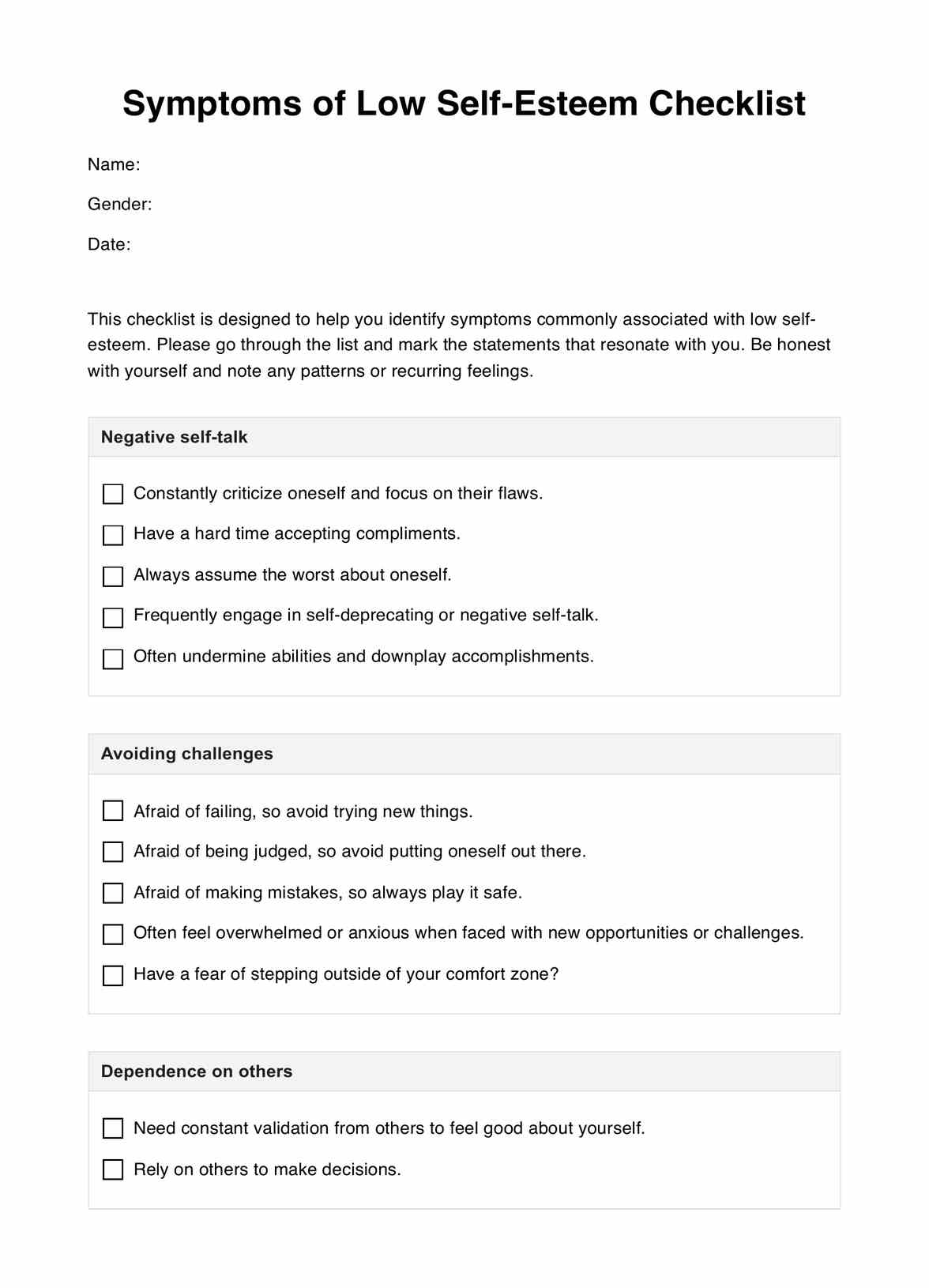
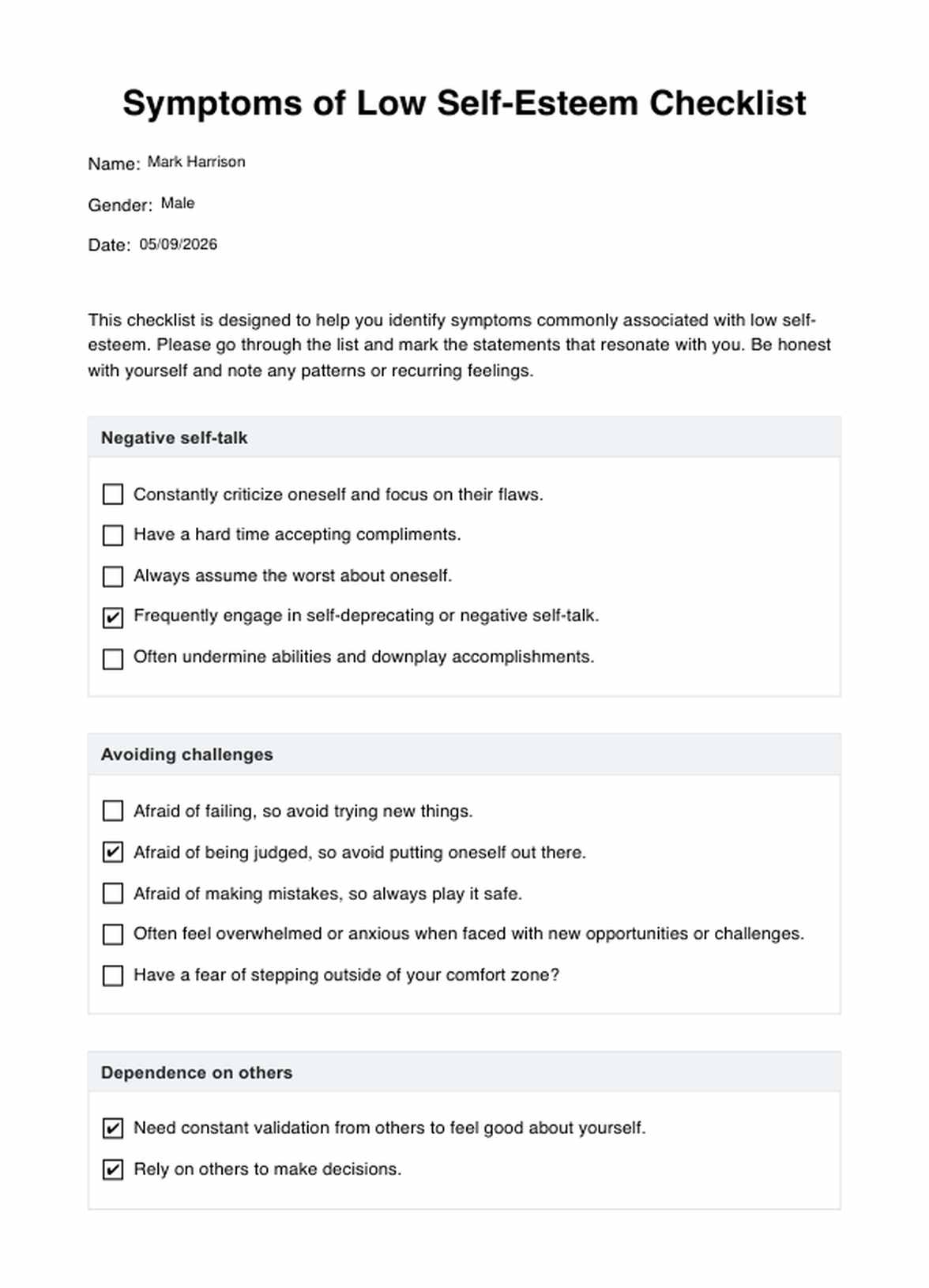

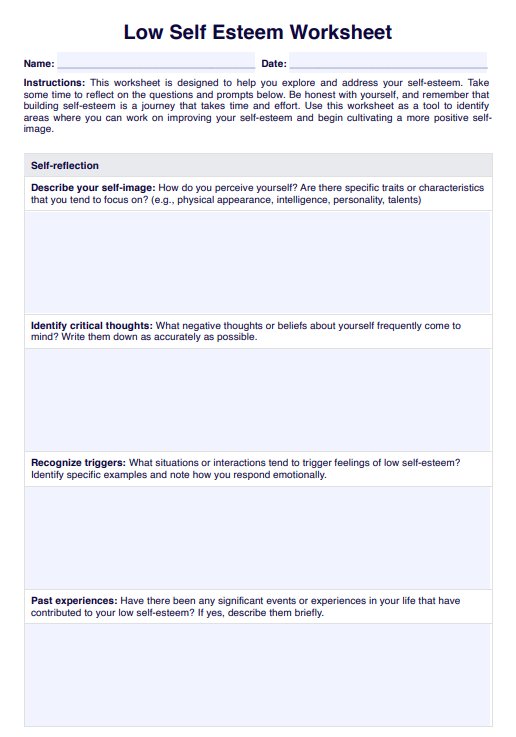














-template.jpg)





















































































